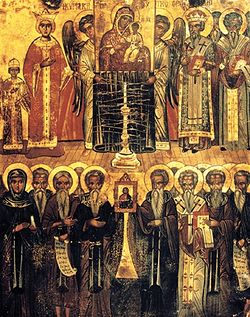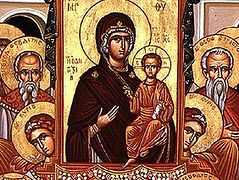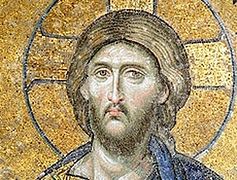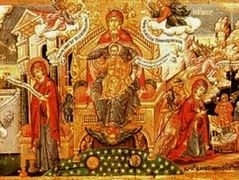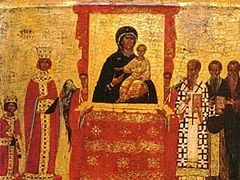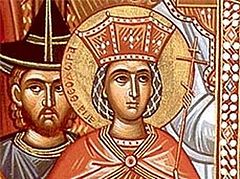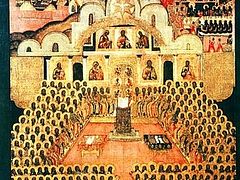Source: Fr. Sergei Sveshnikov
We have come to the end of the first week of the holy salvific, and great Lent. We heard the prayerful canon of St. Andrew of Crete, in which we recalled people and events from the history of the Church, the history of humanity. But it is not for the sake of a history lesson that we gathered in church each evening. While hearing about the sinners of old who lived thousands of years ago in far-away places, we sorrowfully recognized our own sins. But it turns out that from the righteous ones we are truly separated by thousands of years and kilometers.
Today, on the first Sunday of Great Lent, we recall one more event from Church history. In memory of the defeat of the iconoclast heresy, the Holy Church established in the 9th century the feast of the Triumph of Orthodoxy. This heresy, which tormented the Body of Christ for over a century, was condemned at the seventh Ecumenical Council[1] and again by the Synod of Constantinople, the period of Christological debates within the Church came to an end, and the Orthodox teaching was re-established.
The iconoclast heresy rejected not only the icon as a window through which a ray of light may shine into the darkened human soul, but also the Orthodox teaching about Christ as fully God and fully human in the hypostasis of God the Son.
But, like everything in the Church, this feast is established not merely for historiographic reasons, and it is not by accident that the Fathers of the Church established this feast on the first Sunday of Great Lent. The Triumph of Orthodoxy in the soul of each one of us is the goal of Great Lent; triumph over falsehood, heresy, and the snares of the devil, and achieving Orthodoxy in our souls is the goal of our whole life. And one of the central issues of the Orthodox state of our soul and our life is the question of Who Christ is for us and how we worship Him. It is precisely this question that Christ posed to His disciples (Matt. 16:15), and upon the rock of Peter’s answer established His Church (Matt. 16:18).
In the end, it is an incorrect answer to this question that defines every heresy. “Who do you say that I am?” (Matt. 16:15) Only God, Who appeared in human form as a ghost, a mirage? Only human—a great prophet who knows the mysteries of God—but only human? Whom did the Most Holy Virgin bear—a human, who was destined to become the chosen vessel of the Holy Spirit, or pre-eternal God Himself?
Finally, which prototype does the Church venerate of the icon- undescribable and unimaginable God, Whom no one has ever seen (John 1:18), a created Body, which can be depicted but is a creature like all others, or the incarnate hypostasis of God the Son? How do we relate to Christ? As a hireling, expecting to receive our reward according to a contract, as an accused man who is sure of his acquittal because someone else took the blame for his crime, or as a person dying from a fatal illness who entrusts his life to the hands of a merciful Physician, begging for healing? Each heresy found its own answers to these questions, and each time the Church Fathers rose up to defend the Orthodox teaching.
This is why our Church is holy, apostolic, and patristic. It is holy, because it is created by the Holy Spirit Who sanctifies, enlightens, cleanses, and makes the Church whiter than snow. The Spirit of God prepares the Church, the bride of Christ, to stand before the Divine Groom blameless, untarnished by sin, falsehood, and heresy.
We call the Church Apostolic, because the apostles, the pillars of the Church, having received God’s grace on the day of Pentecost (Acts 2:1-4) and authority from Christ to bind and loose for the salvation of human souls (Matt. 16:19), freely gave this Grace through bishops to the entire Church. As grapes do not grow other than on a grapevine, in the same way there cannot be a Church without a bishop. Without apostolic succession there can only be a club of amateur gardeners who get together to read gardening manuals, but there cannot be a Church.
We call the Church patristic because the holy fathers brought the fruits of righteous life and true theology on Christ’s vine, from which we eat, being strengthened in our life and faith.
The Holy Orthodox Church, our loving mother, protects us, her children, from all evil. And gives us only the healthiest and most nutritious fruits, and shields us from harmful and poisonous things. We, in turn, often do not listen to the mother’s advice and run from good. Even worse, we begin to puff up with pride, imagining that we are more educated, wiser, and more spiritual than the holy fathers, and that the path that led them to salvation is not acceptable for us, that it is archaic, that we know better which rules and rubrics to follow and which ones to ignore. To borrow a description from the Protodeacon Andrei Kuraev, we act like a person who enters the cockpit of a modern jetliner and, not comprehending the purpose behind the controls, declares that half of them are unnecessary; or as a person who has not even passed Biology 101, but enters a neurosurgeon’s office and declares that half of the surgical instruments are useless because he does not understand their purpose.
It is just as unintelligent to come to the tree of the Church, not knowing how to grow and ripen fruit, and to declare that the roots are unnecessary, the trunk can be cut down, the branches broken off. It is not for us to create the Church; “I will create”, says Christ. Ours is either to be in it and bear fruit or to be cut off from the Church and to entertain ourselves by reading gardening manuals.
Let us then, brothers and sisters, follow the spirit of the holy fathers and apostles, emulating their lives. Let us follow the Church rubrics and keep the fast. Let us live our lives in such a way that the Triumph of Orthodoxy, defeat of heresy, may become the state of our souls and not merely a historic event.
[1] The Seventh Ecumenical Council convened on September 24, 787 in Nicaea.

